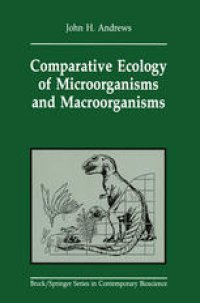
Ebook: Comparative Ecology of Microorganisms and Macroorganisms
Author: John H. Andrews (auth.)
- Tags: Ecology, Zoology
- Series: Brock/Springer Series in Contemporary Bioscience
- Year: 1991
- Publisher: Springer-Verlag New York
- Edition: 1
- Language: English
- pdf
The most important feature of the modern synthetic theory of evolution is its foundation upon a great variety of biological disciplines. -G. L. STEBBINS, 1968, p. 17 This book is written with the goal of presenting ecologically significant anal ogies between the biology of microorganisms and macroorganisms. I consider such parallels to be important for two reasons. First, they serve to emphasize that however diverse life may be, there are common themes at the ecological level (not to mention other levels). Second, research done with either microbes or macroorganisms has implications which transcend a particular field of study. Although both points may appear obvious, the fact remains that at tempts to forge a conceptual synthesiS are astonishingly meager. While unify ing concepts may not necessarily be strictly correct, they enable one to draw analogies across disciplines. New starting points are discovered as a conse quence, and new ways of looking at things emerge. The macroscopic organisms ('macroorganisms') include most represen tatives of the plant and animal kingdoms. I interpret the term 'microorganism' (microbe) literally to mean the small or microscopic forms of life, and I include in this category the bacteria, the protists (excluding the macroscopic green, brown, and red algae), and the fungi. Certain higher organisms, such as many of the nematodes, fall logically within this realm, but are not discussed at any length.
The objective of this unique text is to present a conceptual synthesis of plant, animal, and microbial ecology. Focusing on the application of ecological and evolutionary principles to the individual organism, the author discusses topics such as genetic variation, nutritional mode, size, growth and growth form, life cycle, and interaction with the environment. He concludes with a summary of similarities and differences in the life histories of micro- and macroorganisms. His central premise, illustrated by examples from diverse areas of ecology, is that in the broad range of aspects considered here, all organisms have been similarly shaped by evolution operating through differential reproductive success and thus promoting the development of analogous traits.
The objective of this unique text is to present a conceptual synthesis of plant, animal, and microbial ecology. Focusing on the application of ecological and evolutionary principles to the individual organism, the author discusses topics such as genetic variation, nutritional mode, size, growth and growth form, life cycle, and interaction with the environment. He concludes with a summary of similarities and differences in the life histories of micro- and macroorganisms. His central premise, illustrated by examples from diverse areas of ecology, is that in the broad range of aspects considered here, all organisms have been similarly shaped by evolution operating through differential reproductive success and thus promoting the development of analogous traits.
Content:
Front Matter....Pages i-xvi
Introduction: Prospects for a Conceptual Synthesis....Pages 1-17
Genetic Variation....Pages 18-62
Nutritional Mode....Pages 64-99
Size....Pages 100-143
Growth and Growth Form....Pages 144-177
The Life Cycle....Pages 178-207
The Environment....Pages 208-236
Conclusion: Commonalities and Differences in Life Histories....Pages 238-250
Back Matter....Pages 251-302
The objective of this unique text is to present a conceptual synthesis of plant, animal, and microbial ecology. Focusing on the application of ecological and evolutionary principles to the individual organism, the author discusses topics such as genetic variation, nutritional mode, size, growth and growth form, life cycle, and interaction with the environment. He concludes with a summary of similarities and differences in the life histories of micro- and macroorganisms. His central premise, illustrated by examples from diverse areas of ecology, is that in the broad range of aspects considered here, all organisms have been similarly shaped by evolution operating through differential reproductive success and thus promoting the development of analogous traits.
Content:
Front Matter....Pages i-xvi
Introduction: Prospects for a Conceptual Synthesis....Pages 1-17
Genetic Variation....Pages 18-62
Nutritional Mode....Pages 64-99
Size....Pages 100-143
Growth and Growth Form....Pages 144-177
The Life Cycle....Pages 178-207
The Environment....Pages 208-236
Conclusion: Commonalities and Differences in Life Histories....Pages 238-250
Back Matter....Pages 251-302
....